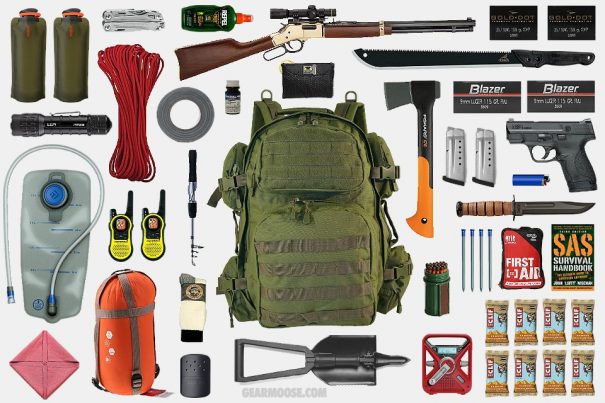Prepper hacks: How to make modular bug-out bags
Sunday, May 05, 2019 by Zoey Sky
http://www.bugout.news/2019-05-05-prepper-how-to-make-modular-bug-out-bags.html

Planning and preparing a bug-out bag (BOB) can be daunting, especially if you’re new to prepping and you’re not sure what kind of gear you’ll need when SHTF. The modular BOB method isn’t new but is usually overlooked by preppers who use built-in compartments in a backpack or those who pack all loose equipment into the main compartment of a bag. (h/t to ModernSurvivalOnline.com)
What are modular BOBs?
A modular BOB groups its contents broadly into “subloads” or self-contained modules in their own containers or packaging. Packing your main equipment groups together in discreet bundles makes it easier to add or remove items you need. This is also tidier than rummaging through loose items, which can be a hassle even if you pack items neatly.
The modular BOB turns your bag into a big container for several modules. Each subload contains a group of supplies like fire-starting and medical gear.
The advantages of a modular BOB
A modular BOB can be loaded or unloaded in a hurry without making a mess of your gear. When SHTF, you can easily pack your BOB with subloads that are specific to certain situations. A modular BOB lets you take needed equipment from it to cross-load into a smaller pack, or even standalone for a quick outdoor trip.
A modular BOB has a flexible design that lets you remove and give needed equipment or supplies to other people in your group without having to rummage in your BOB.
Depending on how you prep your modular BOB, you won’t even need to remove or open it to remove a certain subload.
The disadvantages of a modular BOB
A modular BOB isn’t as space-efficient as simply packing the items into a backpack. The containers holding each module’s contents can make your BOB bulky.
If you don’t pack your BOB properly, you may be stuck with “useless” weight. The total weight and bulk of a modular BOB may be minimal, but they still add up.
When SHTF, you may spend some time rummaging in your BOB if you’re not familiar with the layout. Cost is another factor, especially since you need to buy or make subload bags or containers. This will add to the already significant cost of a fully equipped BOB.
How to prep modules
If you prefer to keep your gear organized, the modular BOB method can also be adapted into other aspects of your life, such as your luggage or go-bag.
Cooking module
This module includes items like a bowl, camp stove, a cooking set, fuel, and other items you need to cook outdoors, excluding the food itself. Since this is usually one of the heavier subloads in your bag, use a sturdy container. Pack this module near the middle bottom of your BOB.
Electronics module
This includes adapters, antennas, backup batteries, charger cables, docks, and solar arrays for your GPS, radio, and smartphone. Bundle cables neatly and use bands, clamps, or straps to prevent them from getting tangled.
Fire and water module
Bundle these two groups together since they both contain small tools that are easy to pack. A typical fire and water module includes a water filter, water purification tablets, a ferro rod, a spare lighter, storm matches, and a tinder box. (Related: These important items deserve a place in every bug-out bag.)
Firearm support module
This module includes items you need for your weapon, such as batteries for optics, a compact cleaning kit and oil bottle, essential spare parts and springs, and spare ammunition.
Food module
Pack your food module based on your eating preferences. Ideal items to include are freeze-dried pouches, granola and energy bars, jerky and other items that stack well and can withstand rough handling.
Medical module
This module contains first aid supplies, trauma gear, and a boo-boo kit.
Items you may need include:
- Antiseptic or iodine solution
- Band-Aid
- Blister relief
- Burn cream
- Compression bandages
- Gauze
- Medical grade super glue
- Medicines
- Med tape
- Scissors
- Suture kit
- Tourniquets
- Tweezers
Pack a medical module in your BOB last so you can access it easily if someone needs first aid. It’s best to use a bag or case specially designed for medical gear to make the module easier to distinguish from other subloads.
Shelter module
This includes everything you need to set up a shelter or raise your core temperature. Keep items like 55-gallon drum liners, a couple of Mylar blankets, a heavy duty tarp, strong cordage, and thick plastic sheeting in this module.
Admin module
Lastly, your admin module includes items you must access regularly to get where you need to go or to solve common bug-out problems. Store items like a compass, a spare flashlight and headlamp, backup batteries, maps, and a whistle in this module.
When choosing pouches for your modules, consider your preferences and whether you want to hook things to the outside of your bag. Ideally, modules should be stored inside a BOB.
Choose materials like military-style pouches in nylon of various weights. Pouches can be made from any material such as canvas, leather, or plastic, as long as it can contain all the items in your module without adding too much weight to your BOB.
When prepping your BOB, consider the modular BOB method for easy organization and cross-loading.
Sources include:
Tagged Under: Tags: bug out, bug out bag, bugout, Collapse, disaster, emergency, Gear, modular BOB, modular bugout bag, multipurpose tools, off grid, prepper hacks, prepping, SHTF, survival, survival gear, Survival Tips, survival tools

